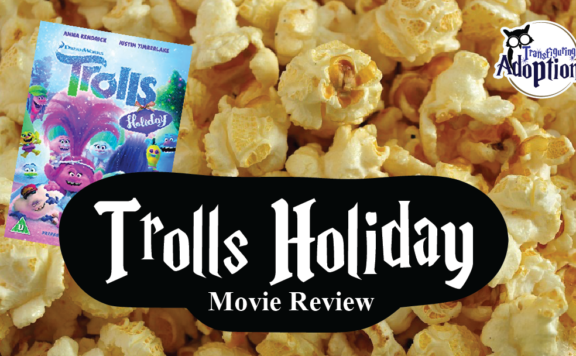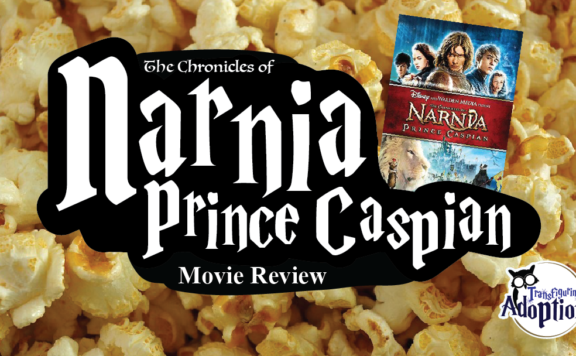Grade:
Transfiguring Adoption awarded this movie 3 Hoots out of 5 based on how useful it will be for a foster/adoptive family. [Learn more about our Hoot grading system here]
Movie Info:
-
Rating: PG-13 (Adventure, Violence)
-
Genre: Action/Adventure
-
Runtime: 127 minutes
-
Studio: Disney
From the Cover of Jungle Cruise (2021) by Disney:
“Join fan favorites Dwayne Johnson and Emily Blunt for the adventure of a lifetime on Disney’s Jungle Cruise, a rollicking thrill-ride down the Amazon with wisecracking skipper Frank Wolff and intrepid researcher Dr. Lily Houghton. Lily travels from London, England to the Amazon jungle and enlists Frank’s questionable services to guide her downriver on La Quila—his ramshackle-but-charming boat. Lily is determined to uncover an ancient tree with unparalleled healing abilities—possessing the power to change the future of medicine. Thrust on this epic quest together, the unlikely duo encounters innumerable dangers and supernatural forces, all lurking in the deceptive beauty of the lush rainforest. But as the secrets of the lost tree unfold, the stakes reach even higher for Lily and Frank and their fate—and mankind’s—hangs in the balance.”
Transfiguring Adoption’s Overview:
Jungle Cruise (2021) is a fun swashbuckling adventure with a number of amusing references to the Disney theme park ride it’s based on. The film stars Dwayne Johnson and Emily Blunt in the leading roles, they have great chemistry and definitely make the movie. The movie has a similar feel to things like Pirates of the Caribbean and Indiana Jones in terms of tone. The film earns its PG-13 rating with a fair amount of violence, scary imagery, and substance use and is recommended for older children and teens.
** Spoilers Could Be Ahead **
How Is This Relevant To Adoption & Foster Care?
Jungle Cruise does not directly relate to foster care, though it does have some themes that may be relevant to foster/adoptive families. We learn that Frank, one of the main characters, was taken in by his friend’s family after he lost his parents and was raised ‘as one of their own’. Later, Frank was faced with the tough choice of turning against his brother in order to protect innocent lives. While not exactly the same, many children in foster or adoptive placements may feel like they are ‘betraying’ their birth families by bonding with other caregivers or being happy after separation and may therefore relate to Frank’s feelings. Additionally, we learn that Lily’s family did not support McGregor when they found out he was gay but Lily stood by him and that’s why they are so close. Often biological siblings in care form incredibly strong bonds due to their shared trauma experience and sometimes lack of other strong family bonds. Therefore, they may relate to the close bond that Lily and McGregor have.
Discussion Points:
- Accepting Help from Others
Lily is incredibly independent and self-sufficient which is one of the qualities that make her a great heroine! However, in some instances she is almost too independent and has difficulty accepting help from others. Given the time period in which this movie is set, Lily’s opinion and scholarly work is often ignored or laughed at because she is a woman. Because of this she has learned to be very defensive and self-sufficient as a means of self-preservation. No one in the academic world takes her seriously so she has had to learn to rely on herself to get things done without help. However, everyone needs help sometimes which is something Lily is forced to come to terms with during her trip down the Amazon with Frank. She learns to trust him to help her and it takes the two of them working together to break the curse and survive the obstacles they are faced with. Children who have a background of trauma often have a difficult time trusting adults and therefore may have a hard time accepting help from their caregivers. Like Lily, they have often been forced to be self-sufficient in their life thus far because the adults in their life weren’t providing adequate care and support. Talking about how Lily learns to accept help and trust others might be a great way to start a conversation about how you can work on those aspects of your relationship together. - Healthy/Unhealthy Family Boundaries
When Frank tells Lily his back story, we learn that he was taken in by Aguirre’s father and the two were raised as brothers. Frank initially sets out with Aguirre to find the tears of the moon to help heal Aguirre’s sister from a terrible illness. They befriend a native tribe who can help them but Aguirre grows impatient and threatens them, demanding the cure for his sister. When they refuse, he begins to slaughter all of the tribe. Frank understands that this is wrong and tries to convince Aguirre to stop but he is unsuccessful. Despite his love for Aguirre and desire to help his sister, Frank makes the difficult choice to help the natives escape instead of blindly supporting Aguirre. This can be a tricky thing to navigate with foster and adoptive youth; they often will feel a familial obligation and loyalty to their biological family, regardless of their behavior or even abuse. This may cause them to feel guilty for developing bonds with other caregivers because it’s ‘betraying’ their birth families. Talking about Frank’s decision to not support his brother when he was making poor decisions may help them unravel their own similar feelings in a safe way and learn about how to set healthy boundaries. - Overcoming Fears
We learn early on in the film that Lily is afraid of the water because she doesn’t know how to swim. Later, it’s imperative that she conquers this fear in order to help those she cares about. She says ‘I can’t swim’ and Frank reminds her ‘you’ve never tried’. Frank helps her by holding her hand and being supportive and encouraging while she faces her fear. Children who have experienced trauma often have a lot of anxiety which may manifest as specific fears based on past traumatic events or a more generalized fear of new things. Of course, if a child has severe anxiety or phobias, it is always best to consult with a licensed mental health provider to work through those in a safe and therapeutic way. However, talking about how Frank helps Lily with her fear of the water may be a way to open a discussion with children about their own fear of the unknown and ways that you as their caregiver can help encourage and support them when trying new things.
Cautionary Points:
- Moderate Violence and Peril
As this is a PG-13 action/adventure movie it goes without saying that there is a good amount of violence and perilous situations. We see a lot of weapons (swords, knives, blow-darts, rifles, torpedoes). There is one somewhat frightening scene of a jaguar attack (though the CGI effects are very obvious). Characters frequently shoot at one another. There are a lot of explosions. The movie’s tone is similar to things like Pirates of the Caribbean or Indiana Jones, so while there is violence and peril, it’s very swashbuckling and almost cartoonish rather than realistic. The pace of the movie is also pretty action-packed and there are very few ‘quiet’ moments. For children who may have an overactive amygdala and have trouble regulating their emotions during adrenaline rushes, this may not be a great choice since the action level stays consistently high, not giving them a chance to deactivate. - Stealing
At the beginning of the movie Lily and McGregor steal an arrowhead artifact from the British historical society. Later, Frank steals back the engine to his boat after it was repossessed by Nilo. In both instances the good guys are stealing from the ‘bad guys’ but it may still be an issue to be aware of, especially if your youth have issues with stealing or not understanding why this is a problematic behavior despite the context of the movie plot. - Brief Mention of Food Insecurity
We learn that Frank owes Nilo a lot of money. When Nilo comes to collect Frank asks if he can ‘keep some so I can finally eat this week’. It’s a very brief throwaway line, but for children who have experienced food insecurity it may be upsetting if they think that Frank is going hungry. - Bathroom/Inappropriate Humor
There are a few small instances of inappropriate humor: McGregor makes a few jokes about wetting himself and there is one time when Frank makes a sexual innuendo while Lily is removing a knife from his chest. In both instances, however, the references are fairly subtle and will likely go over the heads of younger viewers. - Brief Scene of Human Trafficking
During one escape scene early in the movie Lily is apprehended and locked in an animal cage. We overhear a conversation about her fetching a high price from the German prince who is after the arrowhead. It is a very short scene/conversation and she is able to escape pretty quickly. But for children who have experienced human trafficking or punishment involving restraints it may be triggering, despite its brevity. - Family Abandonment due to Sexual Orientation
When Frank asks McGregor about why he is so dedicated to helping his sister he explains that the rest of his family was unsupportive of him when they found out he wasn’t going to ‘conform to the norms of society and marriage’. While they don’t come out and say he is gay, it is heavily implied and so this conversation may be especially upsetting to children who may have lost family support due to their own gender or sexual identity. - Creepy/Gross Conquistadores
There are some undead conquistadores who get woken up and they are pretty gross and look like something out of a horror film or zombie movie. They are essentially corpses and have snakes that crawl out of eye sockets and mouths—definitely not for the squeamish or faint-hearted. - Potentially Problematic Stereotypes
The first two times we encounter the Amazonian Natives (on Frank’s boat tour and later when they kidnap Lily) they are made out to be very stereotypical violent cannibals. We later learn that they are Frank’s friends and that they are ‘part of the act’ and just pretending to be the stereotypical natives to fool tourists and play jokes. However, the scenes before we find this out are somewhat uncomfortable. The film also seems to exaggerate several other stereotypes including Prince Joachim (The German Villain), Nilo (The Italian Dock owner) and McGregor’s homosexuality. While all of these stereotypes felt very tongue-in-cheek and appeared to be making fun of the stereotypes, it may still be harmful to children who identify with some of the cultures the stereotypes depict. - Frank’s Scams/Lying
Frank is the ultimate tourist scammer. He sets up an entire fake tour of the Amazon River designed to frighten and impress tourists who pay to take the ride and elicit tips. He also pretends to be Nilo at first to try and get Lily to pay him to help her and stages a jaguar attack to convince her of his merits. He also gets his friends, the native Amazonian tribe, to pretend to be cannibals and kidnap her and McGregor. When Lily finds out about all of Frank’s scams, she is very hurt and calls him a liar and affects their relationship. Children who have experienced trauma may be more sensitive to acts of betrayal and may feel hurt like Lily does when they realize that Frank has been tricking her and only pretending to be nice. - Alcohol Use
There is quite a bit of drinking by all of the characters during the movie. All of the characters are adults and the drinking isn’t a major plot point but something to be aware of, especially if it’s a trigger for your youth. - Character (Almost) Death
There are two instances when we believe Frank to be dead: the first is when he is stabbed and falls into the river. We find out fairly quickly that he survived because he is one of the undead conquistadores. Then at the end of the movie it appears as if he is trapped as part of the forest with the other conquistadores, however Lily is able to revive him with the Tears of the Moon petal. Children may feel upset or anxious about Frank’s fate during these brief periods when he appears to have died, especially if they have experienced significant loss themselves. - Near-Drowning
After Frank convinces Lily to face her fear of the water and swim down into the river to help him unlock the mechanism there is a brief period where something goes wrong and Lily is trapped in a cage under the water and struggling to breath. Frank is able to swim down and provide her enough air to make it through until they get the mechanism working. However, for children with a fear of water or drowning this scene is likely to be upsetting to watch.
Discussion Guide:
- Who was your favorite character in the movie? Why?
Caregiver Note: This is mostly just a fun question to get the conversation going! However, talking about our favorite characters and why we like them can offer a lot of insight into our own selves. For example, maybe a child identifies with Lily because she’s self-sufficient or Frank because he is lonely but covers that up with his bravado. The important thing with this question is to explore the why behind the choice. If children are reluctant to start a conversation it can help for you to go first and talk about your favorite character to get things going. - We see Lily steal the arrowhead from the museum and later Frank steals back the engine to his boat even though he has not paid it off yet. Do you think they were right or wrong in their actions?
Caregiver Note: Lily and Frank are both viewed as the heroes in the movie and yet we see both of them engage in behavior that is wrong, such as stealing. In some cases, it can be hard to reconcile that a ‘good’ character is doing a ‘bad’ thing so it’s worth having a conversation about. Does your youth feel like ‘the end justifies the means’ in this case? Is Frank right to take back the engine because the (loaner man) isn’t a nice guy and Frank is trying to help someone? Is Lily justified in taking the arrowhead because no one listened to her when she asked nicely? These are tricky questions for anyone, but youth who have experienced trauma may have an even harder time navigating moral grey areas and understanding the nuances or right and wrong. This could open up a great conversation about a difficult topic. It’s also a great way to remind them that just because someone does a ‘bad’ thing, it doesn’t make them a bad person. Frank and Lily are both heroes, despite the fact that they sometimes make poor choices or break the rules. - How do you think Lily feels when she finds out that everything Frank does is part of an act and isn’t real? Have you ever experienced something similar? How did it make you feel?
Caregiver Note: It can be very overwhelming to believe something was real only to find out that someone was ‘just pretending’. Children who have experienced trauma at the hands of their caregivers often feel especially sensitive to betrayals as they likely felt that same sense of a rug being pulled out from beneath them. It’s also interesting to see that this is the first time Frank realizes that one of his scams genuinely hurt someone he cares about, which can be another great realization to talk about here.
- McGregor clearly does not like being outside in the wilderness and is well outside of his comfort zone on this trip. Why did he come with Lily even though it means sacrificing his own happiness?
Caregiver Note: We learn that McGregor feels an intense loyalty to Lily because she supported him when everyone else in his family turned on him for being gay. He cares a lot for his sister and is willing to do anything to help her, even if it means making sacrifices and doing something that scares him. Biological siblings who experienced trauma together often form incredibly close bonds. This question can be a great way to talk about their own sibling relationships.
- Lily is very self-sufficient and independent, sometimes having a difficult time accepting help. Do you think this is a good thing or a bad thing? Does this change throughout the movie?
Caregiver Note: Independence and self-sufficiency are great qualities, but even positive qualities can be detrimental when there’s too much of them. Lily is often reluctant to accept help because she has a hard time trusting others to really have her best interest at heart. Children who have been through trauma are likely to relate very strongly to this. Because of their lack of positive caregiving, they often had to take care of themselves or even their siblings and can have a very difficult time trusting adults. Talking about their opinion of Lily’s self-sufficiency and how she learns to trust others and accept help could be a great way to start a dialogue about how you can help them learn to trust you.
- How does Lily’s trust towards Frank change throughout the movie? What kinds of things cause her to trust or distrust him?
Caregiver Note: The conversation here goes along with the previous question, as Lily’s willingness to accept help is interconnected to developing trust in him. Talk to children about how you can help demonstrate your support of them and ways in which you can work on building that trust together so that they are able to accept help from you when they need it.
- How do you think Frank felt being alone all those hundreds of years? What kinds of things did he do to help with his loneliness?
Caregiver Note: We learn that Frank was one of the cursed conquistadores and is 400 years old. He is also the only one who wasn’t frozen in place so he lived a very solitary life without any real family and friends that he greatly outlived. One of the ways Frank was able to combat his loneliness was through hobbies and learning new things (drawing, playing instruments). He also talks about how he started taking in orphaned jungle animals and caring for them. This could be a great way to talk to youth about strategies they can utilize when they feel lonely or sad, as well as to remind them of the importance of having a ‘village’ of people around them and that you are part of that village.
- Do you think it was hard for Frank to stand up to Aguirre? Why do you think he made that choice even though it was hard?
Caregiver Note: It can be very difficult to stand up to those we care about. For children who have been through trauma this can be an especially hard thing. They feel a strong loyalty to their biological family and may feel a lot of guilt for being happy or developing relationships with new caregivers. They may also have felt like they were responsible for breaking their family apart if they disclosed abuse or neglect that resulted in removal from their home. Frank was raised alongside Aguirre as brothers so it was probably very upsetting for him to disagree and fight against him. However, Aguirre was making a bad choice by slaughtering innocent people and so Frank felt like it was something he needed to do. This can be a great way to talk about how you can love someone without necessarily supporting all of their decisions and that it’s okay to have a different belief than a family member.
- Lily is afraid of the water because she doesn’t know how to swim. How is she able to overcome her fear? How can I help support you in facing your fears?
Caregiver Note: As stated above, any severe phobia or anxiety should absolutely be discussed with a mental health professional so that it can be approached in a therapeutic and safe way. However, talking about the ways in which Frank gently encouraged and supported Lily to face her fear of swimming can be a great way to talk about how you can best support your youth when they have to try new things or do something they’re nervous about.
- Frank and Lily both want different things in the end: Frank wants a chance to ‘rest’ because he feels like he’s lived long enough. Lily wants Frank to come back to England with her. How to they reconcile this? Do you think they made the right choice?
Caregiver Note: This is another question where there isn’t really a ‘right’ answer but it’s an interesting one to talk about. It can be hard when our loved ones want something different for themselves than we want for them. Either choice that gets made here requires a sacrifice; if Frank gets what he wants (to rest), it means that Lily has to say goodbye and never see him again. If Lily gets what she wants, Frank has to give up his chance for peace and possibly not be able to end the curse and stop Aguirre for good. It can be hard to let go of a loved one, but sometimes it’s necessary to say goodbye in order to support what they need and want.
About the Author: Jenn Ehlers
Jenn is a central Virginia native who received her BA in Psychology from the University of Virginia in 2012. Since then she has worked for a local mental health agency and the Department of Social Services in various capacities and has been involved in her community’s efforts to create a Trauma Informed Network. Currently Jenn works in vocational rehab and mentors youth in foster care. When she isn’t working, Jenn enjoys writing stories, anything and everything Harry Potter, and spending time with her niece and nephew.
**Transfiguring Adoption is a nonprofit organization seeking to nurture growth in foster and adoptive families by giving a HOOT about their families. Transfiguring Adoption does not intend for its reviewers nor its review to be professional, medical or legal advice. These reviews and discussion guides are intended to help parents to better be able to connect and understand their children who come from traumatic backgrounds.







